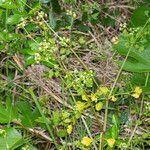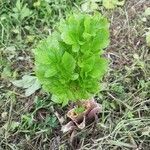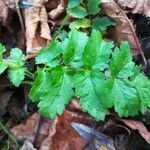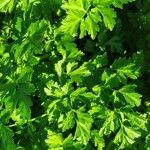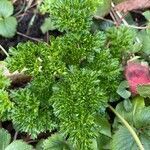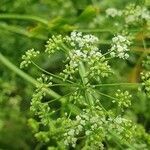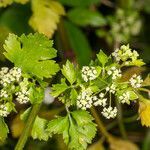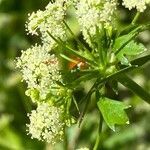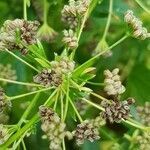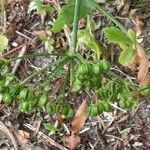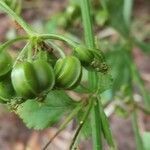Main root fusiform or tuberiform. Stems 25-90 cm, angular, striate and grooved. Petioles rather long; sheaths to 2 cm in the lower leaves, white-margined; lamina pinnate, leaflets 2-2½ by to 3 cm, trilobate to tripartite, petiolulate, in the upper leaves smaller, ternate to 3-partite. Compound umbels opposite the leaves; peduncles 0-2 cm; rays 10-15, 1-3 cm; pedicels 6-10, 2-3 mm; involucres and involucels absent. Calyx teeth absent. Petals ½ mm through, white or greenish, with inflexed tips. Mericarps 1 by up to ¾ mm, ribs narrowly winged; stylopodium nearly ¼ mm high, halves conical. Carpophore emarginate.
Erect terrestrial biennial, not rooting at nodes. Stems hollow, grooved, striate, up to 80-(100) cm high. Basal lvs 1-2-pinnate, petiolate; ultimate segments deltate or rhombic, lobed and crenate or dentate near apex, 2-4 cm long, ± sessile; stem lvs similar to basal but often apetiolate and becoming 1-pinnate or 3-foliolate with elliptic-obovate, entire or lobed segments. Umbels 2-5 cm diam., compound, ± sessile and lf-opposed, and so appearing bracteate; rays 4-15; bracts and bracteoles 0. Fls numerous, greenish white, c. 1 mm diam. Fr. broadly ovoid, dark brown, 1.5-2 mm long; ribs light brown, filiform.
Plants 15–150 cm, strongly fragrant. Basal leaves oblong to obovate, 7–18 × 3.5–8 cm, 3-lobed to 3-parted; ultimate segments subrhombic, 1.2–2.5 × 0.8–2.5 cm, crenate or serrate. Upper leaves short-petiolate; blade broad-triangular, usually 3-parted, ultimate segments obovate. Umbels 1.5–4 cm across, usually leaf-opposed; peduncles usually short, 4–15 mm, stout, rarely obsolete; rays 3–8(–16), 0.5–2.5 cm, slender; umbellules 7–25-flowered, 6–9 mm across; pedicels 1–1.5 mm. Fruit 1.3–1.5 × 1–2 mm. Fl. and fr. Apr–Jul.
Erect, robust, biennial or perennial herb, up to 1 m high; strongly aromatic. Stems hollow, coarsely grooved. Basal leaves 100-170 mm long, fleshy, simply pinnate; segments ± deltoid, lobed, margins crenate-serrate, 10-60 mm long; petioles sheathing. Umbel rays 6-16, 7-25 mm long. Involucre and involucel absent. Flowers white or greenish white. Calyx teeth absent. Flowering time Aug.-Mar. Fruit broadly ovoid, 1.5 mm long, with broad furrows between slender ribs.
Biennial or perennial herb. Flowering stems up to 1 m high; erect, glabrous, yellowish green. Leaves radical and cauline, compound; blade 1-or 2-pinnate; segments ± deltoid, margins lobed, crenate-serrate, upper ones becoming sessile. Flowers: umbels shortly stalked or sessile; involucral bracts 0; white or greenish white; Oct.-Dec., May. Fruit with broad furrows between slender ribs.
A herb that grows over 2 years. It has a strong smell. It grows 30-100 cm high and spreads 15-30 cm wide. The root is bulbous and fleshy. The stems have strong grooves. The leaves are finely divided. They are 50 cm long. The flowers are in small flat heads. They are green-white. The seeds are small and grey-brown. The seeds have ridges on them.
Biennial or perennial, robust, strongly smelling herb, 0.3-1.0 m high. Leaves simply pinnate; segments ± deltoid, lobed and crenate-serrate. Involucel wanting. Fruits with broad furrows between slender ribs. Flowers white or greenish white.
Lower leaves simply pinnate, 10–14 cm. long, with deltate-rhomboid segments up to 4·5 cm. long, often deeply 3-lobed; bases distinctly sheathing; the lower ones obviously petiolate, the uppermost more or less sessile.
Fruit c. 1·5 mm. long, very broadly ovoid; stylopodium depressed; styles c. 0·5 mm. long; carpophore shortly 2-cleft.
An erect biennial or perennial herb, with the characteristic smell of celery, up to 1 m. or sometimes a little more.
Bracts 0, rays 7–15, up to 2·5 cm. long, rather unequal; bracteoles 0, with flowers on pedicels of 1–5 mm. long.
Stem leaves ternate with rhomboid segments to narrowly lanceolate-elliptic and subentire above.
Stem with prominent rather coarse grooves, rising from a large fleshy taproot.
Umbels terminal and lateral, shortly pedunculate or ± sessile in leaf axils.
Distinguished by the biennial, stout, erect habit and large leaves.
Vittae solitary in the intervals and 2 on the commissural face.
Calyx teeth obsolete; petals greenish-white.

